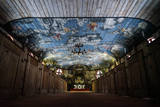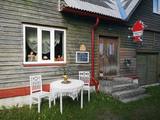| Nr | Name | Beschreibung |
|---|---|---|
|
Dieses Museum ist eines der ältesten Freilichtmuseen in Europa. Hier sind 118 alte Gebäude aus allen kulturgeschichtlichen Regionen Lettlands aufgestellt. Man kann Höfe der lettischen Bauer, Handwerker und Fischer (auch livische Höfe) und eine Wirtschaft der russischen Altgläubigen aus der Region Latgale besichtigen. Interessenten werden eingeladen, traditionelle lettische Feste und Bildungsprogramme zu besuchen. Hier arbeiten Handwerker und ist das Wirtshaus Priedes krogs geöffnet. |
||
|
Veselībai un pilsētvidei draudzīga transporta – velosipēda lietotāji putnu vērošanas torni var sasniegt pa Ķengaraga promenādes veloceliņu. Tornī izvietoti putnu attēli, kas nezinātājiem atvieglo ūdensputnu vērošanas un atpazīšanas procesu. Redzamas plašas Daugavas ainavas. |
||
|
Die Route ist für aktive Fußgänger geeignet, die auf ihrer Reise sowohl Landschaften, als auch die Gefühle des Tales des eindrucksvollsten Flusses der baltischen Länder genießen möchten. Die Route beginnt in Sigulda, die historisch als die Schweiz der Region Kurzeme genannt wurde. In der Umgebung von Sigulda kann man einige der schönsten Landschaften Lettlands genießen. Die Route überquert mehrere tiefe Täler der Nebenflüsse von Gauja und legt die Ufer des Flusses frei, die im Baltikum mit seinen Sandsteinfelsen der Devonperiode bekannt sind. Die Naturpfade von Līgatne ist der einzige Ort in Lettland, wo in waldiger Umgebung, unter naturnahen Umständen und in großen Pferchen unseren Wäldern charakteristische Tierarten wohnen, die Besucher besichtigen können. Aber Tiere und ihre Fußabdrücke kann man auch besichtigen, wenn man auf den Naturpfaden und in den Wäldern des Nationalparks Gauja wandert. Route information from Latvijas Lauku forums |
||
|
Die Reiseroute von Riga nach Tallinn verbindet Natur-, Kultur- und kulinarische Aspekte und umfasst 15 Naturpfade, Moore, Wiesen und Wälder entlang der Ostseeküsten Lettlands und Estlands. Sie führt Sie direkt dorthin, wo regionale Spezialitäten hergestellt werden, damit Sie sie frisch und unverfälscht genießen können. Sie werden erleben, wie Neunaugen auf einem Grill für Sie zubereitet werden, leckeres hausgemachtes Eis probieren, geräuchertes Fleisch auf Bauernhöfen und vieles andere mehr verkosten. Am Ende der Reise werden Sie ein echter Experte der traditionellen und der modernen lettischen und estnischen Küche sein! Da sich die Bauernhöfe, die Lebensmittel produzieren, oft in wunderschönen Naturlandschaften befinden, kombinieren Sie auf dieser Tour Kulinarisches auch gleich mit Erholung. Es gibt viele Naturpfade, an denen Aussichtstürme zur Vogelbeobachtung stehen. Auf den Randu-Wiesen bei Ainaži findet sich ein Drittel der gesamten in Lettland vorkommenden Pflanzenarten. Ein Holzweg führt durch Schilf zu einer Aussichtsplattform mit Blick auf Wiesen und Ostsee. Flora und Fauna der Insel Saaremaa unterscheiden sich sehr von jenen auf dem Festland. Den Besucher erwarten hier eine Kalkstein-Steilküste, ausgedehnte Wacholderheiden, Meteoritenkrater und Orchideenwiesen. Die Tour führt vorbei an Bauernhöfen und durch Dörfer, wie sie typisch für die Küstengebiete Estlands sind. Die Insel Hiiumaa ist ein besonders ruhiger Ort; eine typisch estnische, ländliche Atmosphäre hat sich hier bewahrt. Ausflugsziele sind die bedeutenden Vogelschutzgebiete an den Boddengewässern von Käina, die Landzunge Sääre Tirp und die vielen kleinen Inseln vor der Südostküste. Auf dem estnischen Festland gewährt die Pakri-Halbinsel bei Paldiski mit ihrer ehemaligen sowjetischen Marine-Militärbasis einen Einblick in die jüngere Geschichte des Landes. |
||
|
Dieser Teil des Waldweges führt durch das historische Zentrum von Valmiera. In Valmiera können Sie die St.-Simon-Kirche, die Ruinen der Livländischen Ordensburg und das Valmiera-Museum besuchen. Wir empfehlen auch, den Barfußweg in den „Sajūtu Parks“ (Park der Sinne ) zu gehen. Nach der Besichtigung von Valmiera führt der Waldweg durch den Atpūtas-Park (Erholungspark), den wunderschönen Kiefernwald und das Winterskizentrum Baiļi. Weiter gehen Sie den Abuls Trail entlang und biegen am Ufer des Flusses entlang bis zur Brenguļi-Brauerei, die in einem alten Wasserkraftwerk gebaut wurde. Hier können Sie ungefiltertes und nicht pasteurisiertes Bier genießen. Weiter unten betreten Sie unbewohnte Waldgebiete und das geschützte Landschaftsgebiet Nord-Gauja. Die Wälder in Nord-Gauja („Ziemeļgauja“) sind sehr vielfältig. Es gibt alte oder natürliche boreale (nördliche) Wälder und Sumpfwälder, Eichenwälder, Schwemmwälder (gebildet auf Flusssedimenten, die regelmäßig überfluten) und gemischte Eichen-, Wych-Ulmen- und Eschenwälder entlang des Flusses. Die Tour endet in der Stadt Strenči. |
||
|
The area known as the territory of high hillocks has several heights – Lakta Hill (250 metres above sea level), Egļu Hill (268 metres above sea level), and Bākūži Hill (272 metres above sea level). They are connected by an earthen road – it’s worth hiking the trail to find the best viewing areas. A very fine view of the backs of hillocks in the Vidzeme highlands can be seen from the northern side of Lakta Hill.
|
||
|
Vieta, ko nekādi nevar uzskatīt par tūrisma objektu, bet tajā pat laikā tas ir Latvijas mērogā nozīmīgs kultūras un vēstures piemineklis, ko nevar nepieminēt! Laikā no 1923. – 1943. gadam muižas pilī atradās Latvijā zināmākā mājturības skola, kurā mācījās izslavētās kaucmindietes! Tagad muižas pils ir pamesta, avārijas stāvoklī un apskatāma tikai no ārpuses un „pa gabalu”. Ap 1780. gadu celtā pils, kas 1909. – 1912. g. tika pārbūvēta pusloka būvapjomā, ir Latvijai diezgan unikāls arhitektūras paraugs. |
||
|
Found in the Alsunga Museum, the workshop has been open since 2009, showing people how various ceramics can be made from clay. Visitors can try their hand at the task or just watch as the clay is shaped, spun and, finally, glazed. |
||
|
The spoon workshop offers useful objects such as wooden spoons, cutting boards, butter knives, pans, spatulas, etc. You can produce your own wooden spoon and look at finished spoons made of more than 17 different types of wood from Latvia. During the summer the owners offer “pancake tours” with tasty jams. You can purchase spoons and homemade wine. |
||
|
Lahemaa – the oldest and biggest national park in Estonia – is waiting to be explored. Experiences include a guided nature walk in the bog, a peaceful afternoon in a traditional fishing village, cooking with the local family, a traditional sauna, some farm work and taking part in the local social life. |
||
|
Es gibt Zeugnisse, dass die erste Mühle hier gleichzeitig mit der Burg im 13.Jh. erbaut wurde. Zur Zeit Herzog Jakobs wurde in der Mühle Schießpulver hergestellt. Später war sie der erste Ort in Kurland, in dem Papier hergestellt wurde. Seine jetzige Gestalt erlangte das Gebäude im 19. Jh. In der Sowjetzeit befand sich hier eine Metalverabeitungswerkstatt. |
||
|
Operdziedātāja Jāņa Zābera muzejs "Vecais ceplis" atklāts 1973. gada 11. augustā - dziedātāja dzimšanas dienā - viņa dzimtajās mājās. Muzejā apskatāmas fotogrāfijas no viņa dzīves gājuma, afišas un operu tērpi. Tāpat pieejami dziesmu un operu āriju ieraksti mākslinieka izpildījumā. Muzeju pārzina Jāņa Zābera brāļa meita ar ģimeni. To ir iespējams apmeklēt, iepriekš saskaņojot laikus.
|
||
|
This chapel is interesting in form and made of field stones. It was built in the 19th century and is not open to the public. |
||
|
Im südwestlichen Teil der ehemaligen Flugplatz von Spilve sind noch immer betonierte Plätze erhalten geblieben. In der Zeit der Sowjetunion wurden diese Plätze als Station für militäre Drehflügler genutzt.
|
||
|
Lahemaa bedeutet auf estnisch “Land der Buchten“. Der erste Nationalpark im Baltikum (1971). Der Park wurde für den Schutz der biologischen Vielfalt, Inseln, geologischen Objekte, archeologischen Denkmäler, Landgüter, Fischerdörfer u.a. gegründet. |
||
|
The Samovar House is a small samovar museum located in the Old Believers’ village near Lake Peipus, which has a private collection with more than 100 different and very special samovars and objects related to samovars.
|
||
|
Atrodas 0,3 km ziemeļos no Vecpiebalgas pilsdrupām. Ap 10 m augsto, bet visnotaļ izteiksmīgo Grišku kalnu sauc arī par Piebalgas, Balgas un Veļķu pilskalnu. 13. gs. šeit bijusi svarīga apmetnes vieta ar mākslīgi nostāvinātām nogāzēm un dziļu aizsarggrāvi. Vēstures notikumi ir atstājuši ap metru biezu kultūrslāni. Bezlapu laikā no kalna paveras skats uz Vecpiebalgas baznīcu un pilsdrupu vietu. Pilskalna piekājē ir aka ar Griškavotu. |
||
|
Den Bau des Hauses begann 1924 Jānis Čakste (1859 -1927), der erste lettische Staatspräsident (1922 -1927). Zu seinem 140.Geburtstag 1999 wurde im Haus „Auči“ eine Ausstellung über sein Leben und Wirken und seine Familie eröffnet. Man kann das Arbeitszimmer Čakstes besichtigen und im Ausstellungsraum Arbeiten von Jelgaer Künstlern. |
||
|
Das Restaurant befindet sich im Zentrum von Talsi, am Rande der Lielā Straße. Hier kann man Gerichte aus dem Kochbuch der Großmutter, aus der Küche der Welt und ein breites Angebot an Weinen bestellen. Das Restaurant arbeitet mit lokalen Bauern zusammen. Lettische Küche: Sauerkrautsuppe mit gebratenen Schweinerippen, Graupensuppe mit Waldpilzen, Hering mit Quark, Graupengrütze, geschmorter Braten mit geschmortem Sauerkraut, Lammfleischbraten, Quarkfladen, in Lettland hergestellte Biersorten. |
||
|
Rekovas dzirnavas ir unikāla vieta pašā austrumu pierobežā. “Pirmajā stāvā bija miltu malšana un otrajā stāvā apstrādāja vilnu. Dzirnavas pastāvēja līdz 1980.gadam. Vēlāk ēka nevienam nepiederēja, lietus ietekmē iebruka jumts un faktiski viss bija sadrupis. 2016.gadā zemnieku saimniecības “Kotiņi” saimniekam Aldim Ločmelim radās iespēja iegādāt ēku un saliekot galvas kopā, radās ideja, ka ēkā varētu būt vietējās produkcijas veikaliņš.” Majestātiskā trīsstāvu pamatīgu laukakmeņu mūra ēka, kas atrodas pašā Balvi-Viļaka ceļa malā, ir sākusi dzīvot jaunu dzīvi, kur ikvienam ir iespēja nobaudīt vietējo Latgales produktu garšu dažādā izpildījumā. Dzirnavu saimniece - viena no īstajām latvju saimniecēm Vija Kuļša uzņem tūristu grupas, kurām piedāvā nobaudīt vietējo Latgales produktu garšu dažādā izpildījumā. Ēdienkarte sastāv no piedāvājuma vegāniem, veģetāriešiem un klasiskās ēdienkartes. Viena no galvenajām ēdienu sastāvdaļām ir zs “Kotiņi’’ ražotā produkcija. Ir iespēja pieteikt un darboties arī Meistarklasēs. Tiek piedāvāvāts ēdiens no linsēklām, linu eļļa, dažādi salāti, ko var gatavot ar linu eļļu. Linsēklas izmanto pašu ceptā maizītē, sāļajā baltmaizē ar linsēklām. Linsēklas Rekovas dzirnavu ēdienkartē ir tikai viena no izejvielām, bet tieši tās ir centrālais varonis jaunajā Ziemeļlatgales kultūrvēsturiskā tūrisma piedāvājumā “Linu ceļš Ziemeļlatgalē”. |
||























